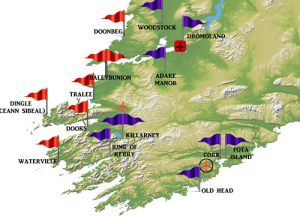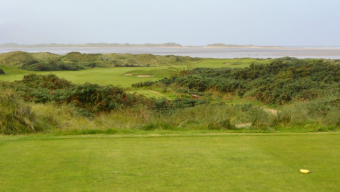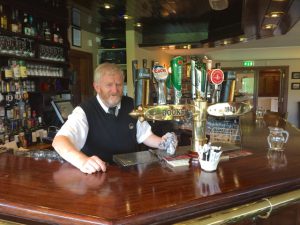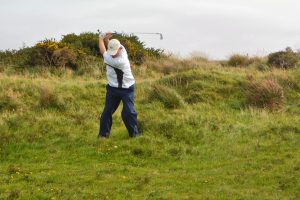Editor’s Note: During this difficult time dealing with the Coronavirus outbreak, leaving golf writers nothing to write about, we decided to revisit some of the places we have gone over the years. Today, we continue our 11-part Irish golf series at Dooks.
(Ninth of an 11-part series)
GLENBEIGH, County Kerry, Ireland — Dooks Golf Links has been a golfing institution around here for 128 years, one of the oldest in all of Ireland.
By next summer, the course should be just about finished.
Dooks sits on the north end of the Ring of Kerry in southwest Ireland, sticking its tongue into Dingle Bay. To the south are the graceful Macgillycuddy Reeks, the highest mountain range in the country.
Dooks is a nifty, unheralded links layout that has a welcoming, neighborly feel, a bit of a contrast to the mighty Waterville Golf Links or the splashy new Hogs Head course, both just south down the Ring road.
As Dooks general manager Maurice O’Meara described it: “You are delighted to be here. You can take a breather.”
It’s almost Links Lite. This is not to say that it’s any less of a challenge or that the wind blows gently off Dingle Bay or that the marram-grass covered dunes are any less of a hindrance. It’s still loaded with drama, deterrents and dunes. After all, Dooks is the Gaelic word for dunes. It merely doesn’t have the far-reaching reputation as the better-known links. But its reputation is gaining traction and destined to get much better.
 One thing that makes Dooks a bit unique is that its footprint is smaller. That means tighter, an alarming warning for golfers already worried about the notorious winds carrying balls to places unknown and unseen.
One thing that makes Dooks a bit unique is that its footprint is smaller. That means tighter, an alarming warning for golfers already worried about the notorious winds carrying balls to places unknown and unseen.
Dooks has been this way forever, beginning as a nine-hole circuit in, around and through the various dunes, farmlands and natural obstacles. It stayed that way for most of the 20th Century as the members stubbornly held onto their quirky little tract.
In 1965, the members desperately fought off factions that wanted to convert the land for other functions and started a national ‘Save Dooks’ campaign. It came perilously close to disappearing but the members ultimately succeeded and purchased the property outright.
Many of those same members wisely expanded it to 18 holes in 1970s, trusting the wise eye of late and legendary Irish links course designer Eddie Hackett, the force behind so many courses, such as Waterville, Carne and Donegal.
Then in 2002, another famed designer, Dr. Martin Hawtree, was brought in for a look. It turned into a long look. Over the next four years he overhauled the property, making vast changes, moving 16 greens. The new Dooks re-opened in 2006 and quickly took its place among the must-play links for overseas visitors.
Yet that wasn’t enough. It’s still tight in places, as the staff will tell you that a day doesn’t go by when at least one ball strays off the first fairway and pings against the clubhouse.
More changes are coming. Beyond the 10th green, a good distance from the clubhouse, the club has acquired an appealing 19 acres along and above the water.
“It has taken 30 years to convince 27 different land owners to sell,” O’Meara said. “It’s something the members wanted. It’s stunning. When you go out there and stand on the top of the hill and look back. Stunning.”
The new area is stacked with all the links elements, proximity to the sea, winds, dunes, gorse, sticky rough and a canyon. Hawtree, now 70, again is in charge in what is said to be his swan-song project. Ground will broken in January and should be ready by the summer.
The final design has not yet been approved but tentatively the intent is to add five or six holes, one over the canyon abyss, widen the 10th fairway and shift the green toward the sea. Then the club will eliminate the current 16th and 17th holes, converting them into a driving range/practice area.
The 18th hole, with its iconic hidden green behind two large dunes, will be untouched, although it may be switched to the opening hole, thereby preserving the clubhouse from its daily ball barrage.
The project needs to be undertaken with environmental limitations, including safeguarding the Natterjack Toad, the club’s cute tiny green emblem. The toad’s breeding ponds are scattered throughout the property.
That’s a multitude of changes to a popular, venerable property. Too many, too much? O’Meara is aware of that concern, saying, “you don’t want to ruin 128 years of history.” But will the locals and visitors miss the old quirks and contours?
“Not really,” he said. “The land is so natural. Hawtree is so well respected. He doesn’t want to make it perfect. He doesn’t want manicured dunes with manicured greens.”
The hope is that the club can improve its stature and its place among the other Ireland courses. “We’re just outside the top 20,” O’Meara said. “We want to get into the top 20 and get closer to the top 10.”
As it stands now, for many it’s easily inside the top 20. It’s in the true links tradition and a great challenge. The best example of what you can expect is the par-3, 174-yard fourth hole. The left side seems to encroach on your sense of fairway, or fair play. You might believe that if you hit your drive straight it will be all right, but the gorse and rough seem to reach out and grab your shot. And won’t give it back.
Then if you start your drive off a little right of center there’s a decent chance the prevailing ocean winds can carry it to rough areas right. It’s simply a narrow passage to success.
The seventh hole, a par-4, 469-yarder, needs to be as straight as possible. Your drive should find its way through a narrow dune valley. Drifting to either side means you will have a blind shot over a large dune on the fairway return.
On the par-4, 426-yard 18th, most golfers end up on either side of the 40-foot dunes, which are hiding the green, somewhere back there. That’s also fairly thick rough. Unless you can see your way through the dune sandwich, your approach to a rather large green will be blind.
That’s a fine way to a memorable finish. Or, perhaps when the course someday is finally finished, a memorable start.
DOOKS GOLF CLUB
Location: Glenbeigh, County Kerry
Opened: 1889
Architect: Original unknown, Dr. Martin Hawtree, rebuild
Type: Links
Tees: Blue (6,586), White (6,327), Yellow (5,979), Red (5,379)
Par: 71
Green Fees: May-October: $80-120 (Euros); November-April: $50-80
Memorable Holes
No. 4: Par-3, 174 yards. Painfully tight; ocean wind from left, unforgiving gorse left, dunes right.
No. 5: Par-4, 464 yards. Drive needed between narrow dune valley; straight mandatory to green.
No. 17: Par-3, 173 yards. Drive over OB fence onto a turtleback green, tough to land.
No. 18: Par 4, 426 yards. Drive placement importance for a clear shot at dune-protected green.
THURSDAY: Ballybunion
























